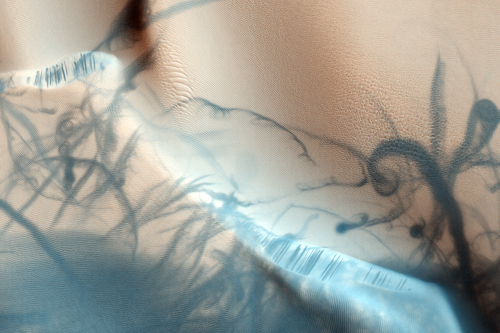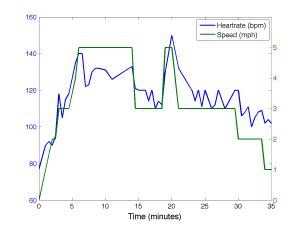Today was the first day of the Lunar and Planetary Science Conference in The Woodlands, TX (north of Houston). Here are three highlights from today’s sessions:
 Ray Arvidson described sulfate-enriched sand observed by the Spirit rover (“still a rover, not a lander,” he insisted). The sulfates are interpreted as forming in a warm, moist environment created by the ancient volcanism in the area. There are several distinct layers, and the sulfates are found at the bottom, supporting a hypothesis that this area experienced periods of high obliquity (axial tilt) that caused this near-equatorial region to be much colder (and covered in snow).
Ray Arvidson described sulfate-enriched sand observed by the Spirit rover (“still a rover, not a lander,” he insisted). The sulfates are interpreted as forming in a warm, moist environment created by the ancient volcanism in the area. There are several distinct layers, and the sulfates are found at the bottom, supporting a hypothesis that this area experienced periods of high obliquity (axial tilt) that caused this near-equatorial region to be much colder (and covered in snow).
“Thus while embedded on the side of Scamander crater Spirit has uncovered evidence for two timescales of water-related processes: formation of aqueous deposits associated with early volcanic activity and subsequent continuing redistribution of soluble species associated with orbitally-induced climatic change.”
Two-page abstract (PDF): “Recent Scientific Results from Spirit’s Observations of Sulfate Sands on the Side of Scamander Crater, Columbia Hills, Mars” by Ray Arvidson and the Athena Science Team
By the way, if you’re worried about Spirit, you can browse the latest Free Spirit news. Although it’s been declared a “stationary science platform”, chances are very good that when spring returns and there is more power available from its solar panels, the Spirit team will again see if they can extricate its wheels.
 John Grotzinger provided an update on the upcoming Mars Science Laboratory (MSL) mission (due to launch in 2011) and what landing sites are most attractive in terms of searching for evidence of past life. MSL will be able to search for ancient biosignatures in terms of complex organic molecules, unusual isotope ratios, and unusual rock textures. (I was particularly interested in the last point, since it relates to my work on detecting structural biosignatures by analyzing rock textures.) The original four landing sites being considered are Holden Crater, Mawrth Vallis, Eberswalde Crater, and Gale Crater.
John Grotzinger provided an update on the upcoming Mars Science Laboratory (MSL) mission (due to launch in 2011) and what landing sites are most attractive in terms of searching for evidence of past life. MSL will be able to search for ancient biosignatures in terms of complex organic molecules, unusual isotope ratios, and unusual rock textures. (I was particularly interested in the last point, since it relates to my work on detecting structural biosignatures by analyzing rock textures.) The original four landing sites being considered are Holden Crater, Mawrth Vallis, Eberswalde Crater, and Gale Crater.
“While each site has its own particular strengths, they share in common two very important attributes: definitive evidence for the former presence of water as seen by either mineralogic or morphologic features (or both), and the presence of prominent stratigraphic sequences, hundreds to thousands of meters thick in some cases, suggestive of sedimentary rocks.”
On January 4, 2010, the MSL Landing Site Steering Committee voted to add two new candidates: Northeast Syrtis and East Margaritifer. Stay tuned for more news as they whittle these finalists down!
PDF: “Mars Science Laboratory, Preservation Potential of Biosignatures and Environmental Records, and the Attributes of Promising Landing Sites” by John Grotzinger
And finally, I also attended at least one non-Mars talk! Richard Vondrak gave an overview of the current status of the Lunar Reconnaissance Orbiter (LRO), which began its science observations last September. The goals of this mission are to identify safe landing sites, locate useful resources, measure the radiation environment, and test a Synthetic-Aperture Radar (SAR) device.
After a four-day cruise, LRO arrived at the Moon and settled into a commissioning orbit for three months. This highly elliptical orbit took it as low as 30 km above the south pole (periselene, its closest approach to the Moon) and out to 216 km away at aposelene. It then transitioned into a circular orbit (at an altitude of 50 km) for its 12-month nominal science mission. This orbit, interestingly, takes a lot of effort; if LRO does not periodically fire its thrusters to maintain it, the spacecraft will lose 15 km of altitude per month and shortly crash into the Moon. While that was an intentional activity for LCROSS, LRO would prefer to achieve a longer lifetime and even to win an extended mission.
 The amount of data being returned by this mission is phenomenal. Due to its relative proximity and a dedicated ground station, LRO is able to return much more data than any Mars mission; in its first 3 months it collected 55 TB (to be released by the Planetary Data Service on March 15) and by the end of a year, it will have accumulated more than 140 TB. By that point it will have depleted its station-keeping fuel and then revert to an elliptical orbit. But no doubt it will still be eager to collect more data!
The amount of data being returned by this mission is phenomenal. Due to its relative proximity and a dedicated ground station, LRO is able to return much more data than any Mars mission; in its first 3 months it collected 55 TB (to be released by the Planetary Data Service on March 15) and by the end of a year, it will have accumulated more than 140 TB. By that point it will have depleted its station-keeping fuel and then revert to an elliptical orbit. But no doubt it will still be eager to collect more data!
PDF: “The Lunar Reconnaissance Orbiter at the Midpoint of the Exploration Mission” by Vondrak, Keller, Chin, and Garvin
 I also really enjoyed Ron Greeley’s Masursky lecture, titled “Shifting Sands: Planetary Atmosphere-Surface Interactions.” There are so many truly beautiful aeolian features on Mars!
I also really enjoyed Ron Greeley’s Masursky lecture, titled “Shifting Sands: Planetary Atmosphere-Surface Interactions.” There are so many truly beautiful aeolian features on Mars!




